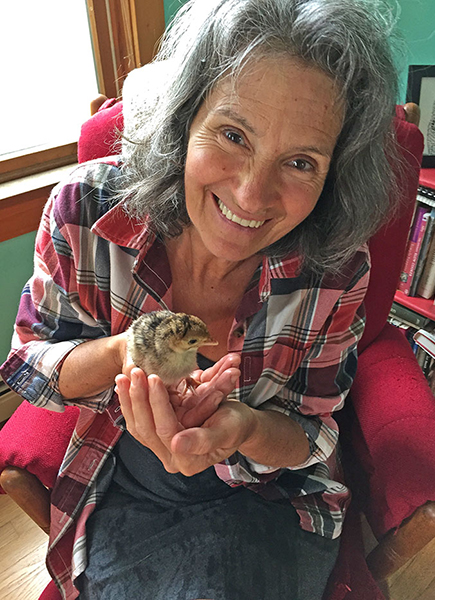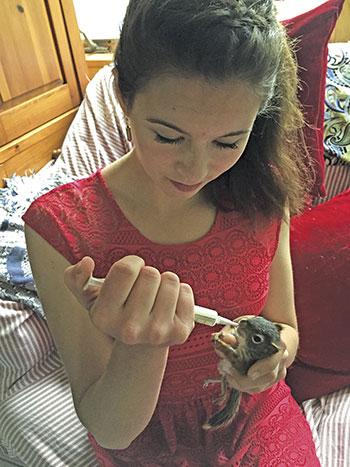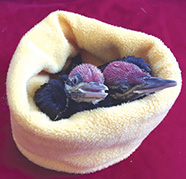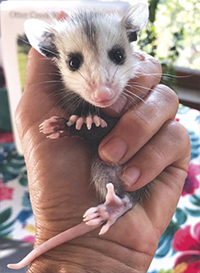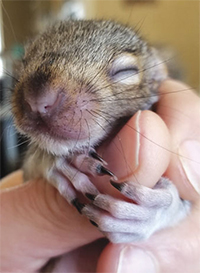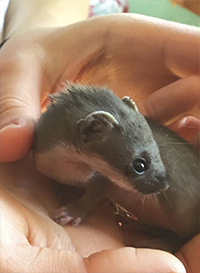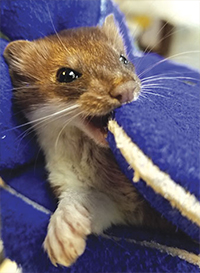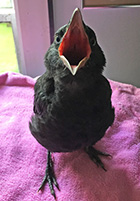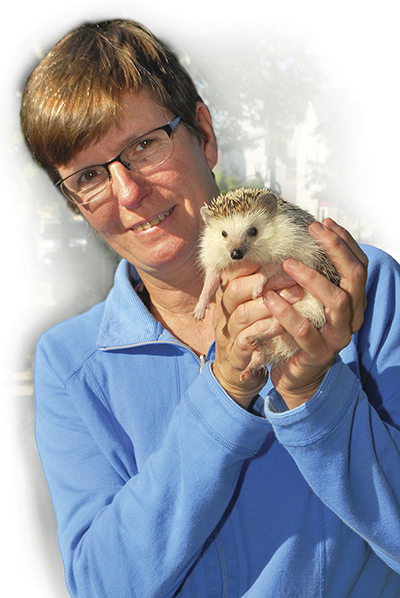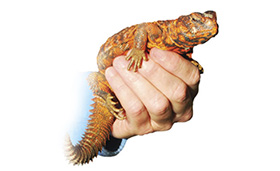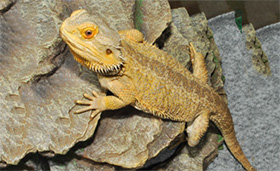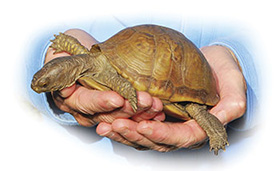| Wild at Heart: Wildlife Rehabilitators in Vermont | |||||
| by Michelle A.L. Singer | |||||
Juliana Parker holds one of her vulnerable charges. |
In Vermont, it is legal to give care to domestic animals like dogs, cats, and rabbits and even “unprotected species” like starlings, pigeons, house sparrows, and mice. However, if you encounter injured or orphaned wildlife, that’s a different story. In order to provide care for them, you have to be a special kind of person: a licensed wildlife rehabilitators. The Vermont Fish & Wildlife Department, under the Agency of Natural Resources, manages the licensing of wildlife rehabilitators and requires a specific process to earn one. Their regulations state, “Only licensed rehabilitators may legally provide care with the ultimate goal of returning the animal to the wild as quickly as possible, giving the animal the best chance of survival. Vermont rehabilitators may legally possess and treat most common birds, mammals, reptiles and amphibians with the exception of deer, moose, bear and wild turkey.” According to their website, there are 18 wildlife rehabilitators in Vermont who have earned their licenses, stretching from Marlboro to Fairfax, Colchester to Barre. Fourteen of these hardworking, big-hearted volunteers are women. I spoke with three of the 14 women who do this work: Julianna Parker of Otter Creek Wildlife Rescue in Addison, Aimee Brown of FourWands Wildlife Rehabilitation in Barre, and JoAnn Nichols of the Chittenden County Humane Society and HEART, her humane wildlife removal business. Julianna Parker will often be the first to take songbirds, ravens, and woodpeckers, but Aimee Brown will most likely be the one to take in squirrels, and if there is a reptile in need, JoAnn Nichols is your woman. These women are talented, knowledgeable, and dedicated. They coordinate with veterinarians, game wardens, dispatchers, and transporters in a network of trained experts to field calls, deliver animals to the appropriate rehabilitators, share supplies, and educate the public. |
||||
“Wildlife rehabilitators need a permit for a good reason,” says Brown, “It’s not as easy as it looks or as straightforward.” Each species has different nutritional needs and schedules that change at different stages of maturity. For example, baby birds must be fed every 20 to 30 minutes, from sunrise to sunset, but they do not need to be fed during the night. Baby mammals have a longer time in between feedings; however, they must be fed through the night. Each volunteer gives her time and works within her expertise to rehabilitate wild animals and release them back into the wild when they are ready and able.
|
|||||
“I find the limitations of the license actually frustrating,” says Parker, who also has a federal license to rehabilitate migrating birds. Although she trains as many people as she can so that the network of available rehabbers can expand, she is limited to five at a time. “I take it step by step, training new rehabbers who are applying for licenses now, making our community better, bigger, and continuing to evolve the support system so that everybody is getting more backup from each other,” she says. “I have a pretty wonderful network, and we try to coordinate what we take so that nothing falls through the cracks, but we need more rehabbers, desperately. Nobody should be taking the volume that we do in the course of a summer.”
Even though Parker has been working with animals since her 20s, she will need to slow down, a little. She appears to have boundless energy, but, she says, “I have leukemia. I was diagnosed in the fall of 2014. It was not a good prognosis, but I have defied the odds and plan to continue to defy the odds, but I take less than I used to. My daughter is also off to college now, so it’s a very different landscape.” Getting 501(c)3 nonprofit status for Otter Creek last year is part of the changing landscape. “I used to work three jobs to support the rehab, but once I got sick I couldn’t do that anymore,” she says. As a nonprofit, the organization is able to raise the money needed for care of wildlife. “I have to maintain a conscious balance between the effort and energy that I put into rehab and the effort and energy it takes to run the rest of my life,” she says. "I could not do what I do without the expert dispatch services of Ellen Jareckie,” she adds. “Ellen gave up her license after 15 years of rehabbing and now provides a dispatch service for wildlife emergencies. She and I work closely together, and she’s wonderful.”
|
|||||
|
|||||
|
Located in Barre, Aimee Brown of FourWands Wildlife Rehabilitation has unwittingly become a squirrel expert. “It wasn’t my intent to specialize in squirrels, it’s just what I ended up getting the most of. Five years ago, I didn’t know what squirrel pox was, and I would not have thought I would ever find out,” she says. Now, she’s developed a protocol for the rare virus that rehabbers hardly see but that Brown has treated five times in the last two years. “Treating a squirrel for squirrel pox involves giving medication three to five times a day for four to six weeks, depending on what’s going on,” she says. “I just stay on top of it and watch it all the time. Sometimes that means 21- to 22-hour days.” Brown works from a converted space above her garage and sees everything from broken bones, malnutrition, and orphaned babies to fractured facial bones, broken pelvises, and, of course, squirrel pox. “When I first applied for my license, someone from fish and wildlife said, ‘Do you know what you’re getting yourself into? It starts out like a trickle but it comes in like a tsunami,’ and boy she wasn’t kidding,” remembers Brown. “My very first intakes were six-day-old red squirrels, and before you know it, I had 29 that I raised that spring, and then another 30 again in the fall, plus other random animals that came in. I probably did about 80 in my first year.” |
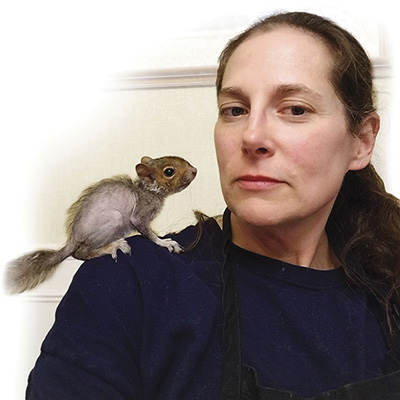
Aimee Brown with Pearl. the miracle squirrel. |
||||
She says she also tends to get an October miracle, an animal she can’t believe is still alive. Last year it was Pearl, an emaciated squirrel who lost all her hair from malnutrition. Brown stayed up all night with her, feeding her diluted formula every 30 minutes until she regained her strength. Pearl became a fan favorite online where Brown keeps up an active presence on her website and Facebook. “I remind people that these animals always have one foot in the wild,” she says. “I post pictures of bites because people see photos of the cute moments, but there are not always cute moments. Sometimes squirrels attack, and often they bite.” She has raised animals since childhood and has a lot of experience handling them, and even she once had a squirrel bite all the way through her finger. “Every year I get such fascinating animals, with such will to live,” she says. Like Kenny the squirrel, found at a Sears store in Burlington. At about six weeks old, Kenny (named after Kenmore appliances sold by Sears) had made it past the double doors and well into the men’s department, where people were taking pictures of him, when he was rescued. Or Penelope the nine-week-old porcupine who has nerve damage to her left foreleg and can’t use it properly. It will take months to heal, and she will need to overwinter at FourWands. Brown hand-fed Penelope with a nippled syringe, which, she says she “learned from Audrey von Lepel up in Fairfax, who specializes in porcupines.”
Though she has knowledgeable people to reach out to, and other rehabilitators to refer to, she says there are simply not enough wildlife rehabilitators to meet the needs. “I have too many critical cases in my care right now,” she says. “I’m so tired. Compassion, fatigue, and burnout are risks. I’m looking forward to the end of the season when I can get some sleep, have time to myself, and do small things like watch TV! I’m tired, but I wouldn’t give it up.” Last winter, Brown housed an entire colony of flying squirrels, about 30, as well as almost 40 other squirrels. “They just kept coming in,” she says. When she realized she would be overwintering them, she put a request on her Facebook page asking for help. “I put out a wish list and I thought it was going to take months to raise the money I needed,” she says. “But everything on my wish list was purchased within 12 hours. I can’t tell you how grateful I was. Not only everything on the wish list but financial donations, so I actually had a reserve fund that allowed me to purchase more food over the winter and provide surgery for one animal that required it.”
|
|||||
JoAnn Nichols with Rick, a rescued African pygmy hedgehog.
|
For JoAnn Nichols, wildlife rehabilitation is just one of the many ways she works with animals. Nichols is a wildlife rehabilitator, the Humane Investigator, TNR (trap, neuter, return) specialist, and Humane educator at the Humane Society of Chittenden County, owner of HEART (Humane Eviction and Removal Team) Wildlife Removal, which is contracted to provide animal control officer services for South Burlington and, in the winter, a veterinary tech assistant for the Burlington Emergency and Veterinary Specialists. Her work with animals has included earning a degree in wildlife photography, cleaning birds from oil spills, investigating animal cruelty cases, removing squirrels, racoons, and other wildlife safely out of homes and yards, and educating kids in the humane treatment of animals, not to mention caring for over 20 animals at the licensed wildlife rehabilitation center in her home. She’s been doing work with vulnerable animal populations since she was 13 years old, volunteering at the SPCA in Delaware, where she’s from. Volunteering turned into a job, which turned into a license for wildlife rehabilitation. When she moved to Vermont 20 years ago, she got her license here and has never stopped. “It’s in my DNA,” she says. Three dogs make up a lively welcoming committee at her home in Burlington: Sadie, Reba, and Lucinda, a boxer who was relinquished as part of a cruelty investigation and was nursed back to life by Nichols. As a wildlife rehabilitator she works primarily with reptiles, many of which are illegal in Vermont except by permit, which she has. |
||||
“People sometimes buy them in other states where they are legal,” she explains, “and find they are not actually able to care for them. Reptiles are sensitive to temperature and humidity, and people don’t always know what they are getting into.” Some of the reptiles in her care include Scooter, a bearded dragon; Sweet Potato and Bumble Bee, two spiny-tailed lizards; and Larry, a jeweled lizard rescued from an animal cruelty case in South Hero involving over 80 animals. Nichols is also rehabilitating three wild painted turtles who have been hit by cars, one with pins in his shell who will need to heal over the winter until the recovery process is complete and Nichols can release him in June when food is plentiful. She also has a red-eared slider turtle left in Nichols’s driveway, a Florida softshell turtle, and an African pygmy hedgehog named Rick who Nichols brings to the Chittenden County Humane Society camps. The outdoor enclosures house Franklin, an African spurred or sulcata tortoise, and Carmen, a box turtle, who also does the camp circuit where “the kids take care of her every day for six weeks,” says Nichols.
In addition to wildlife rehabilitation, Nichols divides her time among the organizations she works for and her own business, HEART Wildlife Removal. She co-owns the humane wildlife solutions business with Patty Tashiro. Nichols originally called her business Into the Wild, but after she helped Tashiro and her family with a skunk in her yard, they joined forces and renamed the business. What they do is unique: Nichols had to work with the Vermont Fish & Wildlife Department to help design the permit for the business. “It fills an important gap in the market,” she says, “folks who have a wildlife problem but who want to be humane about how they deal with it. A raccoon who has made a nursery in the attic, woodchucks or skunks under the porch, squirrels in a chimney, even an opossum in the doorway on Church Street: I’ve seen a lot. People don’t realize that when an animal is removed from their home, it’s illegal to relocate them, so they have to be destroyed.” She doesn’t have the time to take cases outside Chittenden County, although she says she does coach people over the phone occasionally. “I get calls from all over, so I don’t know if anyone else is doing this,” she says. “My goal is to get them out of the home and keep them from getting in again. If there are babies, I remove the mother first. A raccoon can have 20 nests in any given area. She can take her babies to one of the other nests.” In all the work she does, Nichols feels privileged to “see the relationship between people and animals.” Most of all, she wants people who are interacting with animals to “just be kind.” “We catch people when their hearts are open,” agrees Julianna Parker. “We interface with people from all walks of life when they’ve encountered an animal in need and care enough to drop everything to get that animal to help. It is a special moment. Our work can be difficult but very rewarding.” “It restores my faith in humanity,” says Aimee Brown, “to see people go to such lengths to get care for an injured or orphaned animal, and it’s gratifying to be able to help. I love what I do and I’m very fortunate to be able to do it.”
|
|||||
|
|||||
|
Michelle A.L. Singer lives in East Montpelier and can be reached at michellealsinger@gmail.com.
|
||||
